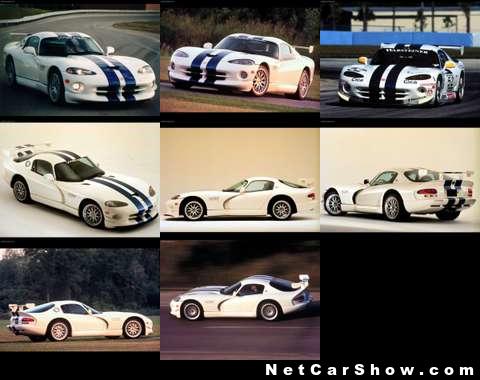Dodge Viper GT2
Although the 1996 model year is the beginning of the second generation, in the Viper community, the 96 RT/10 is sometimes referred to as generation 1.5 since it saw the carryover of many generation 1 parts during the model year while transitioning to generation 2 parts. The roadster relocated the exposed side exhaust pipes to a single muffler at the rear exiting via two large central tail pipes during the middle of the model year. Dodge said the reduced back pressure increased the horsepower to 415 bhp (309 kW; 421 PS) for the 96 RT/10. Torque would also increase by 23 lb·ft (31 N·m) to 488 lb·ft (662 N·m). A removable hardtop was now available along with a sliding glass window. Some steel suspension components were replaced by aluminum, resulting in a 60 lb (27 kg) weight reduction.
Later in the 1996 model year, Dodge introduced the GTS, a new coupe version of the Viper. Dubbed the "double bubble", the roof featured slightly raised sections that looked like a bubble to accommodate the usage of helmets and taking design cues from the Pete Brock designed Shelby Daytona. More than 90% of the GTS was new in comparison to the RT/10 despite similar looks. The GTS would come with the same 8.0 liter V-10 engine but power would be increased to 450 hp (336 kW). The 96 GTS would be the first Viper to be equipped with airbags and also included air conditioning, power windows and door locks.
The 1996 Viper GTS would be chosen as the pace car for the Indianapolis 500.
1997-1999
Minor updates would continue in 1997 and 1998. In 1997, The RT/10 would receive the 450HP GTS engine along with air-bags and power windows. 1998 Vipers were equipped with second-generation air bags, revised exhaust manifolds (saving 24 lbs over the previous cast iron components) along with a revised camshaft.
For 1999, the Viper received 18 inch wheels, power side mirrors and a handful of other interior upgrades.
2000-2002
In 2000, the Viper would no longer have forged pistons. For some enthusiasts of the second generation Viper, this is a less desirable model year since it doesn't have a forged motor like the 96-99 GTS models and does not have ABS like the 2001-2002 models.
2002 would be the final year of the second generation Viper. Dodge would build 360 "Final Edition" Vipers (326 coupes and 34 ACR editions) to commemorate the final year. These models are painted red with white stripes, paying tribute to the famous race-winning Oreca cars. The RT/10 was replaced by the SRT-10 in 2003 and the GTS was replaced in 2006 by the SRT-10 coupe.
Colors and Trim
Colors would vary throughout the second generation. Dodge would offer between three and four colors per model year. Some colors such as Steel Gray were only offered one model year (MY2000) while other colors such as red were offered during the entire second generation. Interior colors and wheel options would also vary throughout the second generation. The cobalt blue colour of the Dodge Viper GTS seen in the Viper (TV series) was exclusively available to the series.
Stripes would be an option beginning in 1996. The GTS stripes were larger fuller stripes than the stripes offered on the 96 RT/10. The GTS had twin stripes (8 inches wide with a 4-inch gap in between) that ran from the front bumper all the way through the rear bumper. 1996 was the only model year the stripes would run through the rear license plate area. Stripes on later models would run from front to rear but did not run through the rear license plate area.
Performance
Extensive modifications included a reworked engine with higher power and less weight, an almost completely redesigned chassis that was made 60 lb (27 kg) lighter and 25% stiffer in torsional rigidity through meticulous computer analysis, a thoroughly redesigned suspension, and reduced braking distances; the 1996 to 2002 Viper GTS had a lighter (approximately 650 lb (290 kg)) 450 bhp (340 kW) engine, which could complete the quarter mile in 12.3 seconds, 0.3 seconds and 6 mph (9.7 km/h) faster than its predecessor, and increased top speed by 11 mph (18 km/h) or so. The revised suspension, stiffer chassis, and aerodynamic body raised lateral grip to 0.98 g (9.6 m/s²), although other reports show the 1992 model with 1.0 g. Contemporary tires have improved upon this measure significantly. Slalom runs could often reach or exceed 70 mph (110 km/h). Brakes once again lacked ABS initially, and proved to be the car's weakest point. The brakes hurt the car in numerous comparison tests, such as a 1997 "supercar comparison" by Motor Trend, in which the Viper GTS placed at the top against cars such as the Ferrari 355, Chevrolet Corvette, Porsche 911 Turbo, Acura NSX-T, Mitsubishi 3000GT, and the Toyota Supra in all performance exercises except braking. The car not only placed last, but had considerably longer stopping distances than other vehicles. In a Sports Car International comparison conducted in 2002, the Viper ACR (with ABS) was compared to the 911 GT2 at Thunderhill Raceway Park. Both cars were very capable, and quick around the test track, but the Viper proved more difficult to drive, and the braking system was blamed very specifically for the gap in lap times (approximately GT2: 2 minutes, ACR: 2:04) between the two cars. Anti-lock brakes were introduced in 2001, though braking performance was not necessarily significantly improved.
This article is licensed under the GNU Free Documentation License. It uses material from Wikipedia.



![2026 Kia Sportage [EU]](/R/Kia-Sportage_EU-Version-2026-thb.jpg)
![2026 Ford Ranger Super Duty [AU]](/R/Ford-Ranger_Super_Duty_AU-Version-2026-thb.jpg)
































